Repair Topics
Toilet Fill Valve Leaking
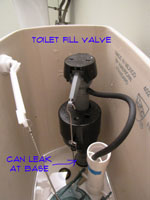 A toilet fill valve leaking is usually diagnosed by a small puddle on the floor. The toilet fill valve is connected to the toilet tank via a compression fitting at the bottom of the toilet tank. A rubber seal keeps the water in the tank from draining out. When the fitting loosens or the seal gets old, leaks can occur.
A toilet fill valve leaking is usually diagnosed by a small puddle on the floor. The toilet fill valve is connected to the toilet tank via a compression fitting at the bottom of the toilet tank. A rubber seal keeps the water in the tank from draining out. When the fitting loosens or the seal gets old, leaks can occur.
Not sure if this is your problem? See the article, 'Toilet Troubleshooting' for a complete listing of all the toilet topics. Related articles to this one are, 'Fill Valve Repair', 'Toilet Tank Issues', 'Toilet Water Supply Lines', follow these links for more information.
There is only one place that a toilet fill valve can leak and that is at the fitting that connects it to the tank. See the information below for instructions on locating it and tightening it.
A fill valve that is allowing water to run over the top of the fill tube and down into the tank is not really a leak. See the article on 'Adjusting a Toilet float' for information on fixing this problem.
Locating the Toilet Fill Valve Fitting
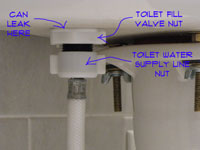 The toilet fill valve fitting is usually located on the left side of the tank (when you are facing the toilet). There will be a plastic or metal nut directly below the porcelain tank bottom.
The toilet fill valve fitting is usually located on the left side of the tank (when you are facing the toilet). There will be a plastic or metal nut directly below the porcelain tank bottom.
You can also identify this by following the water supply line up to the bottom of the tank. The water supply is connected to the toilet fill valve.
Tightening a Toilet Fill Valve Fitting
Shut the water off to the toilet, using the valve at the water supply line.
Take the lid off of the toilet tank. You can flush the toilet at this point to drain most of the water out of the tank. Hold the toilet flapper open to get as much water out of the tank as possible.
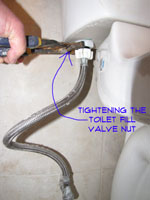
With one hand you want to hold onto the base of the toilet fill valve on the inside of the toilet tank. Use the adjustable pliers to tighten the nut on the bottom of the tank. These nuts are usually plastic, so be careful not to tighten.
When you feel that it is tight check for leaks, there should still be some water in the bottom of the tank. If there is not water leaking turn the water to the toilet back on and let the tank fill. Check for leaks again. If there are no leaks you can put the lid back on. If it is still leaking, you can try tightening again.
If the seal still leaks after tightening, you can replace the seal or replace the entire fill valve. See the article 'Toilet Fill Valve Repair' for more information.
Water Supply Line Problems
The fill valve gets blamed for some leaks that are really the fault of the water supply line. There are two fittings that are very close together at the bottom of the toilet tank. One connects the supply line to the fill valve.
See the article, 'Leaking Toilet Supply Lines' for information on what to do with this situation.
Replacing a Toilet Fill Valve
If the fittings are corroded or damaged, you may need to replace the fill valve. This is not an expensive part and they are readily available at home supply stores. See the article, 'Replacing a Toilet Fill Valve' for instructions on getting this done.
Summary
The toilet fill valve is attached to the tank with a compression fitting. This fittining may need to be tightened to stop the fitting from leaking. It is not a big job, but it is much easier if you first drain the toilet tank.
Fixing a Toilet Flapper Leak
 Fixing a toilet flapper leak is usually diagnosed by a trickling sound of water in the tank. However, you may not always hear it. A certain sign is a toilet tank that fills periodically, even when no one is using the toilet.
Fixing a toilet flapper leak is usually diagnosed by a trickling sound of water in the tank. However, you may not always hear it. A certain sign is a toilet tank that fills periodically, even when no one is using the toilet.
You can use dye tablets to check for a slow leak. See the article 'Toilet Tank Leak Detection Tablets' for more information.
There are three possibilities for this problem. First, the flapper may not be adjusted correctly. The Second possibility is the flapper itself. It may be old and worn out. The Third and least desirable problem is the seat on the toilet flush valve may be worn badly and not allow for a tight seal.
Adjusting a Toilet Flapper
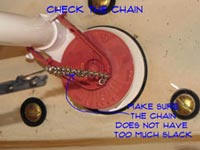 The toilet flapper is controlled by a chain that is connects the toilet handle to the flapper. If the chain is too short, the flapper may not close all of the way, allowing water to leak into the bowl. A chain that is too long, may interfere with the flapper closing completely. Adjusting the chain can solve this problem.
The toilet flapper is controlled by a chain that is connects the toilet handle to the flapper. If the chain is too short, the flapper may not close all of the way, allowing water to leak into the bowl. A chain that is too long, may interfere with the flapper closing completely. Adjusting the chain can solve this problem.
(1) Turn off the water for the toilet at the toilet water supply valve.
(2) Drain the tank by flushing the toilet.
(3) Remove the lid from the toilet tank. It is not fastened and should lift up easily. Be careful where you lay it down. The lid is made of porcelain and will crack and chip easily.
(4) At this point the flapper should be in the down position. Inspect it to see if any portion of the chain is underneath the flapper. Some chains are long and have excess links that have no use. If this is the case, remove the chain from under the flapper and adjust the chain so the excess cannot interfere with the flapper.
(5) Is the chain holding the flapper partially open? Again the chain needs to be adjusted.
(6) You adjust the chain by shortening or lengthening it on the retaining clips that hold it in place. A properly adjusted chain should have a small amount of slack and allow the flapper to close completely. Excess chain should be wrapped around the handle or cut off and discarded.
Replacing a Toilet Flapper
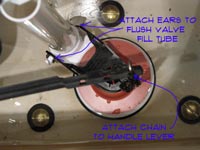
The toilet flapper, as the name implies opens and closes to allow the water from the toilet tank to quickly enter the toilet bowl. The rush of water creates a siphonic action that causes the toilet to flush. When closed the toilet flapper is the only thing keeping the water in the tank.
If the flapper is adjusted properly and it still leaks, the only recourse is to replace it. This is not a big job and generally takes about five minutes. The article 'Replacing a Toilet Flapper' provides complete instructions for this repair.
There are different sizes of toilet flappers. I would be a good idea to take the old one along with you to make sure you get the right size.
(1) Turn off the water for the toilet at the toilet water supply valve.
(2) Drain the tank by flushing the toilet.
(3) Remove the lid from the toilet tank. It is not fastened and should lift up easily. Be careful where you lay it down. The lid is made of porcelain and will crack and chip easily.
(4) Unhook the chain from the toilet flapper. The chain connects the rod from the handle to the toilet flapper. Depressing the handle lifts the flapper, causing the toilet to flush.
(5) The flapper is connected to the toilet flush valve with two rubber ears. You should be able to remove this with just your fingers. Remove the old toilet flapper.
(6) Install the new toilet flapper onto the toilet flush valve. Make sure is moves up and down freely.
(7) Hook the chain to the toilet flapper. You want a little slack on the chain, but not a lot. Test the handle and the flapper when you hook up the chain. Does the flapper open wide when the handle is depressed? A flapper that only opens partially, may close to quickly before all of the water has drained from the tank.
(8) Turn the water back on and make sure the flapper is working properly. This should solve your leaking flapper problem. You can use some 'Toilet Tank Leak Detection Tablets' to make sure.
Replacing a Toilet Flush Valve
The toilet flush valve has the opening that the toilet flapper closes against. Sometimes this opening becomes corroded or deteriorated over time. When this happens the toilet tank will still leak, even with a new flapper installed.
Unfortunately, this is not a simple repair. To replace the toilet flush valve, you need to remove the tank. With the tank removed it is not too difficult to replace the flush valve.
See the article 'Toilet Flush Valve Repair' for instructions on dealing with this issue.
Toilet Flapper Leaking – Summary
Hopefully you have been able to your toilet flapper leaking problem. Most of the time, replacing or adjusting the toilet flapper is an easy task.
How To Fix a Leaking Toilet Tank
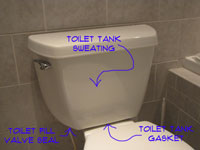 Learning how to fix a leaking toilet tank starts with determing what your problem is.. There are three likely possibilities for a leaky toilet tank. The first is the seal between the tank and the bowl. The second is the seal at the toilet fill valve.
Learning how to fix a leaking toilet tank starts with determing what your problem is.. There are three likely possibilities for a leaky toilet tank. The first is the seal between the tank and the bowl. The second is the seal at the toilet fill valve.
A third possibility is a cracked toilet tank. One other problem that is not really a leak is condensation on the toilet tank that drips onto the floor making a mess.
Not sure if this is your problem? See our complete 'Toilet Troubleshooting Guide' to narrow down the possibilites.
Tightening a Toilet Tank Seal
Most toilets are made of two porcelain castings, the toilet bowl and toilet tank. These two parts are connected together to form the toilet. There is a large rubber seal at this connection that keeps the water inside of the toilet. Two or more bolts hold the tank to the bowl unit. When tightened, these bolts compress the seal to make a watertight joint.
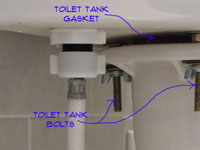 You have likely guessed where this is headed. The bolts can loosen over time and the seal will start to leak. As long as the seal is in good condition, you can tighten the bolts to stop the leak. This repair requires a large screwdriver and an adjustable wrench.
You have likely guessed where this is headed. The bolts can loosen over time and the seal will start to leak. As long as the seal is in good condition, you can tighten the bolts to stop the leak. This repair requires a large screwdriver and an adjustable wrench.
(1) Shut the water off to the toilet, using the valve at the water supply line.
(2) Take the lid off of the toilet tank. You can flush the toilet at this point to drain most of the water out of the tank. Hold the toilet flapper open to get as much water out of the tank as possible.
(3) In the center of the toilet tank you should see the toilet flapper that is attached to the toilet flush valve. The flush valve has a vertical fill tube attached to it.
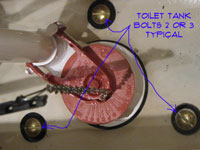 Around the flush valve there will be two or three bolt heads with rubber washers on them. The bolts are secured in place with nuts and washer that are found underneath the toilet tank.
Around the flush valve there will be two or three bolt heads with rubber washers on them. The bolts are secured in place with nuts and washer that are found underneath the toilet tank.
(4) With the large screwdriver in one hand and an adjustable wrench in the other, you can tighten the tank bolts. Use the adjustable wrench to hold the nut from spinning and use the screwdriver to do the tightening.
You want to tighten the bolt evenly, since this also levels the tank. Try a half turn or so for each bolt. If they feel loose, tighten them until the feel snug.
(5) Fill the tank up and check for leaks. If it is still leaking, you will want to try again. When repeated tightening does not solve the problem, it is possible that the seal is bad and needs to be replaced. See the article 'Replacing a Toilet Tank Gasket' for instructions on how this is done.
Tightening a Toilet Fill Valve
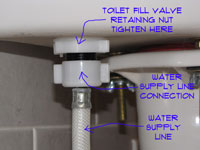
The toilet fill valve provides the water that your toilet uses to work. The toilet tank has a hole in the bottom for the fill valve. The fill valve is held in place by a large nut and a rubber washer.
The washer creates a seal that keeps the water from leaking out around the hole in the bottom of the tank. Tightening the nut will usually stop a leak at this location.
You will need a pair of adjustable pliers for this repair. They need to be large enough for the nut at the base of the tank.
(1) Shut the water off to the toilet, using the valve at the water supply line.
(2) Take the lid off of the toilet tank. You can flush the toilet at this point to drain most of the water out of the tank. Hold the toilet flapper open to get as much water out of the tank as possible.
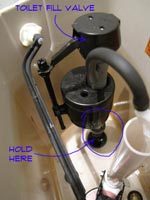 (3) The toilet fill valve is a vertical pipe that is usually on the left side of the tank as you face the toilet. It has a float attached to it that controls when the water shuts off.
(3) The toilet fill valve is a vertical pipe that is usually on the left side of the tank as you face the toilet. It has a float attached to it that controls when the water shuts off.
(4) Hold the base of the flush valve with one hand to keep it from spinning. Using a pair of adjustable pliers, tighten the nut that is directly below the bottom of the tank. There are two nuts at this location, one for the water supply line and one for the toilet fill valve. Be careful not to overtighten, these are usually plastic fittings.
(5) Turn the water back on and check for leaks. If the seal is still leaking after tightening, you may need to replace the rubber washer or the entire fill valve assembly. See the article, 'Toilet Fill Valve Repair' for more information.
Fixing a Cracked Toilet Tank
A crack in a toilet that is leaking may be difficult to repair. There are porcelain repair kits available that can be purchased. Some of them use a fiberglass mesh, this style would need to be used on the inside of the tank. All of them use some type of epoxy.
(1) Purchase a porcelain repair kit.
(2) Shut off the water and drain the tank, by flushing the toilet.
(3) The surface will need to be dry before the repair can be made. Let the tank dry completely for several hours. You can use a hair dryer to speed up the process.
(4) Carefully follow the instructions for the repair kit and patch the crack.
(5) Allow to dry thoroughly before refilling the tank.
Toilet Tank Condensation
This problem is not really a leak. Instead it is a result in differing temperatures and humidity. At times this problem can make a mess on your floor, requiring extra work to mop up the excess water.
The condensation occurs when the tank fills with cool water, usually around 50 to 60 degrees, and the room temperature is much warmer. The humidity in the air will cause the moisture in the air to condense on the cool surface of the toilet tank. Water droplets will form and run down the side of the tank.
After the water temperature inside of the tank adjusts to the room temperature, the condensation will stop. There are a few things that can help, and a few rather expensive solutions that are listed below.
(1) They make insulating blankets for toilet tanks. These may not solve the problem entirely, but they also absorb any water that does condense, thus reducing the mess.
(2) You can try running the a fan inside the bathroom to increase the air circulation.
(3) Adjusting the room temperature with your homes air conditioning system. If the difference in temperature is reduced the condensation will be reduced in a corresponding amount.
(4) There are also more expensive tempering valves and tempering tanks. The idea would be to fill the tank with water that is already at room temperature. These solutions will involve plumbing modifications to your home.
How To Fix a Leaking Toilet Tank – Summary
From the above, you can see that there are several places that a toilet tank can leak. This article should have provided the information you need to fix the problem and get rid of the leak.
How To Fix a Leaking Toilet
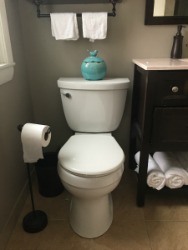 Do you know how to fix a leaking toilet? Leaks can be a little deceptive and it is not always easy to tell where they are coming from.
Do you know how to fix a leaking toilet? Leaks can be a little deceptive and it is not always easy to tell where they are coming from.
The first step is troubleshooting your problem. The 'Toilet Leak Troubleshooting' section below, will help you to do that. After that, you want to get the needed parts and tools. With everything thing you need, just follow the instructions provided to repair your leaky toilet.
Not sure if your toilet is actually leaking? See the article on 'Fixing Toilet Problems' for a complete listing of potential problems and solutions.
The four possible locations are: (1) The Fill Valve inlet. Usually just requires that you tighten the tank seal nut. (2) The Flush Valve seal. Many times , tightening the bolts will solve this problem. (3) The Toilet Flange seal can leak at the floor. This requires pulling up the toilet and replacing the wax ring. (4) The water valve or supply tube can also leak. Tightening may fix it, replacing washers or replacing tubes and valves may be required.
Toilet Leak Repair - Issues Involved
What Can You Save? - Leaks can be a little more challenging, even for a repairman. Initially it will cost you $50 to $100 for a service call, plus parts. If it takes longer than the initial time period (this varies), they generally charge you in fifteen minute increments. $15 to $35 per fifteen minute period. It is unlikely that you need a new toilet if it is just leaking. Assuming a repair period of one service call plus one half hour the Savings would be $80 to $170. Parts would be extra of course, and marked up at a repair shop's pricing.
How Hard Could It Be? - Depending on where the leak occurs the difficulty level can vary. These repairs will have a Difficulty Level of: A Bit of Work. These repairs require a Skill Level of: Handyman. For and explanation of the terms in this section, see 'How to Use This Site'.
Check the Simple Things! - We will cover it in the steps below, but tightening things up is usually pretty simple. If something is obviously loose, get a wrench and tighten it. It may be as simple as that.
What Can Go Wrong? - Leaks mean water, water can be a problem. Left unattended, leaks can damage finishes and structural elements. Letting a leak go for a long time can do thousands of dollars of damage. Fixing it quickly will always be the best course of action. Anything that can be damaged by water should be removed from the area before the repair is attempted. Getting the toilet partially repaired before it gets too late or the parts store closes can leave the toilet not operating. One trick is that a toilet can be flushed by dumping a couple of gallons of water quickly into it from a pail. This mimics the normal function of the toilet tank.
Troubleshooting Toilet Leaks
The descriptions below help you to locate the leak and act accordingly. Try to locate the leak before you take action. A leak at the toilet flange may only leak when the toilet is flushed. Use a dry cloth to soak up the water and then use your finger to determine where the leak is coming from.
Water Trickles Into the Bowl and the Tank Refills Periodically
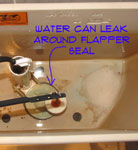 You hear a trickling sound inside of the tank. This is especially noticeable when it is quiet. This is usually accompanied by the toilet tank refilling periodically.
You hear a trickling sound inside of the tank. This is especially noticeable when it is quiet. This is usually accompanied by the toilet tank refilling periodically.
This problem is related to the toilet flapper and the toilet flush valve. The toilet flapper raises when the toilet is flushed. After the water has drained into the bowl, the flapper closes. It seals against the rim of the flush valve. The seal between the flush valve and the flapper is the only thing keeping the water inside of the tank. When this seal fails, you have a leak.
The articles 'Toilet Flapper Leaking' and 'Toilet Flapper Repair' provide information on all of the issues associated with your toilet flapper. This includes instructions on how to fix it.
I have a leak at the base of my tank, where it connects to the toilet bowl.
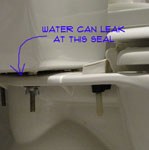 This problem only applies to two piece toilets. However, most toilets are the two piece design. The two pieces consist of a toilet bowl, which is the base unit that sits on the floor and a toilet tank.
This problem only applies to two piece toilets. However, most toilets are the two piece design. The two pieces consist of a toilet bowl, which is the base unit that sits on the floor and a toilet tank.
The toilet tank is mounted to the base unit with bolts. There is a large seal between the tank and the bowl. This seal is compressed by tightening the bolts that hold the two porcelain pieces together. Loose tank bolts can cause the seal to leak. Since the seal is made out of rubber it can also dry out and crack over time. A cracked or worn seal can also leak.
Another potential problem is the bolts. Some toilets use bolts that have a rubber seal around them. There are individual holes in the bottom of the tank for each bolt. You can have the same problem here, a loose bolt or bad seal at the bolt can cause a leak.
The article 'Fixing a Leaking Toilet Tank' has complete instructions for tightening the toilet tank bolts and replacing the seals if needed.
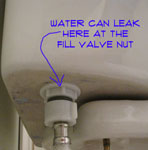 I have a leak where the water supply connects to the tank.
I have a leak where the water supply connects to the tank.
There is another hole in the bottom of the toilet tank for the toilet fill valve. The toilet fill valve regulates the amount of water that is stored inside of the toilet tank. It needs to be connected to the homes water supply.
The toilet fill valve is held in place by a large nut and it has a rubber seal to stop the water from leaking out of the toilet tank. When the nut is loose or the seal is bad, there can be a leak at this location.
For instructions on how to tighten or replace the toilet fill valve, see the article 'Toilet Fill Valve Leaking'.
The water supply line for the toilet is leaking.
Your toilet needs water to operate. The water is provided by a supply line that runs between the shut off valve and the toilet.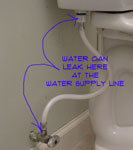 There are actually four different spots that could be leaking on the supply line.
There are actually four different spots that could be leaking on the supply line.
(1) The connection where the valve is attached to the water supply. (2) The connection where the supply line is connected to the water shut off valve. (3) The valve stem seal on the water shut off valve. (3) The connection where the supply line connects to the toilet fill valve.
See the article 'Toilet Supply Line Leaking' for information on how to locate these leaks (pictures included). There are also instructions on how to tighten or repair the problem.
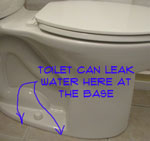 There is water on the floor around the base of the toilet.
There is water on the floor around the base of the toilet.
Just because you have water on the floor, does not mean that the toilet is leaking at the base. Make sure that you do not have another type of leak before you pursue this problem.
A toilet leaking at the base will only occur when the toilet is flushed. That means, well, that the toilet is leaking dirty water from when the toilet is used.
The toilet is connected to the floor with bolts that hold it in place. There is a wax seal between the bottom of the toilet and the toilet flange. When the toilet loosens over time the seal can be broken, causing the toilet to leak.
There are two possible fixes. One is tightening the tee bolts that hold the toilet to the floor. The second is replacing the wax ring. The article 'Toilet Leaking at the Base' has more information and instructions on how to fix this problem.
This is not really a leak at all. This problem comes from condensation on the toilet tank. There are some things that can help. See the article 'Fixing a Leaking Toilet Tank' for some suggestions.
Fixing a Leaking Toilet Tank – Summary
Toilets use a lot of water to operate and water needs to be stored. It is not suprising that they have lots of spots that can leak. Hopefully, you were able to identify your problem and get it fixed.
Did not find an answer to your problem? See the article 'Troubleshooting Toilet Problems' for a listing of all if the toilet issues you might encounter.
How To Unclog a Toilet Without a Plunger or a Snake
Do you know how to unclog a toilet without a plunger or a snake. Essentially, your in a bind without any tools. There are methods that can be tried, but they are not as effective as a good old fashioned plunger.
Time
Waiting for a clog to dissolve can sometimes work.
Water Pressure
You need to be careful with this one. Most toilet bowls will handle two flushes and that's about it if the water is not draining out. A second flush will sometimes build up enough water pressure to push the clog on through.
Chemicals
Chemicals that are strong enough to dissolve clogs are dangerous and should be used with great care.
Zip It
A zip it snake may be long enough to break up a clog in a trap.
Coat Hanger
Yes this can work. A wire coat hanger that has been straightened out can get to a clog and get it loosened up. You may have to play with the shape a bit and work it to get it past the trap.


